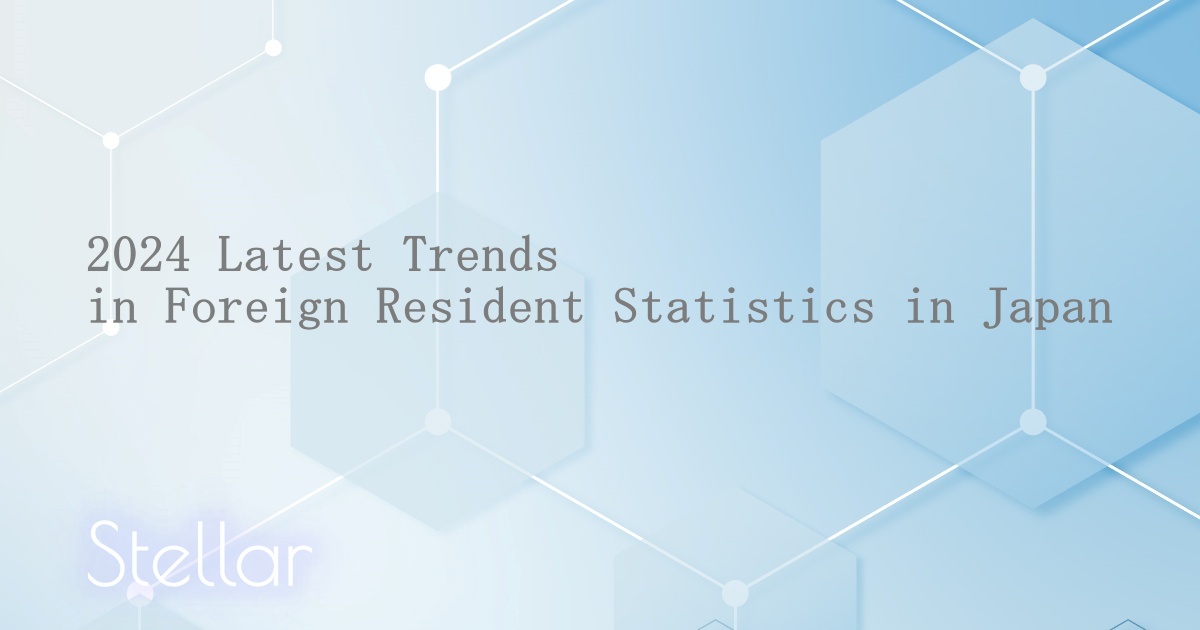Latest Trends in Foreign Resident Statistics in Japan as of the End of 2024

Introduction
In recent years, the number of foreign residents in Japan has been steadily increasing, and the latest data as of the end of 2024 clearly reflects this trend. The press release from the Immigration Services Agency of Japan, dated March 14, 2025, provides detailed information on the number of foreign residents by country and the distribution of foreign nationals by resident status (visa type).
Foreign Resident Population Reaches Record High
As of the end of 2024, the total number of foreign residents in Japan was 3,768,977, marking an increase of 357,985 (a 10.5% rise) compared to the previous year, setting a new record high.
By Resident Status, “Permanent Residents” Lead
Looking at the rankings by resident status (excluding special permanent residents), the largest group is “Permanent Residents,” with 918,116 individuals (an increase of 26,547 compared to last year).
Following that, we have “Technical Intern Trainees” with 456,595 (an increase of 52,039) and “Engineer/Specialist in Humanities/International Services” with 418,706 (an increase of 56,360).
Notably, the number of foreign nationals with “Specified Skilled Worker” status has surpassed 280,000, with improvements in the system and an expansion of eligible fields significantly contributing to this growth.
| Ranking | Resident Status (VIsas) | Number of People (Year-on-Year Comparison) |
|---|---|---|
| 1 | Permanent Residents | 918,116 individuals (+26,547) |
| 2 | Technical Intern Trainees | 456,595 individuals (+52,039) |
| 3 | Engineer/Specialist in Humanities/International Services | 418,706 individuals (+56,360) |
| 4 | Students | 402,134 individuals (+61,251) |
| 5 | Dependent | 305,598 individuals (+39,578) |
| 6 | Specified Skilled Worker | 284,466 individuals (+76,004) |
| 7 | Long-Term Residents | 223,411 individuals (+6,543) |
| 8 | Spouse or Child of a Japanese National | 150,896 individuals (+2,419) |
| 9 | Designated activities | 95,508 individuals (+21,734) |
| 10 | Others | – |
Based on the Immigration Services Agency of Japan’s press release from 2025, prepared by Stellar Immigration Consultancy.
Here are related articles about permanent residency.

Trends of Foreign Residents from 2019 – By Residence Status (Visa)
The table below is cited from the official announcement by the Immigration Services Agency of Japan.

(Cited from the Immigration Services Agency of Japan ‘Press Release for 2025’)
When comparing the five-year period from the end of 2019 (the end of Reiwa 1) to the end of 2024 (the end of Reiwa 6), several residence statuses showed notable increases due to the government’s implementation and expansion of systems and social demands.
- Specified Skilled Worker (No. 1 + No. 2)
- From 1,621 to 284,466 individuals, an increase of 282,845 (+17,448.80%) over five years.
-
The sharp increase from the early stages, immediately following the system’s establishment in April 2019, was due to the full-scale implementation of the system.
From 2023 onward, the expansion of eligible industries and the promotion of transitions to No. 2 visa had a significant impact
- Nursing Care
From 592 to 12,227 individuals, an increase of 11,635 (+1,965.37%) over five years. -
The increase can primarily be attributed to the rise in cases of transitions from the EPA route and student visa statuses.
- Highly skilled professional
From 592 to 12,227 individuals, an increase of 11,635 (+1,965.37%) over five years. -
The government’s development of the system has advanced, and its utilization by companies has also expanded.
- Student
From 345,791 to 402,134 individuals, an increase of 56,343 (+16.29%) over five years. -
Although there was a temporary decline due to the impact of COVID-19, a significant recovery was seen after the lifting of entry restrictions. Particularly, the number of international students from Southeast Asia has increased.
- Permanent Resident
From 793,164 to 918,116 individuals, an increase of 124,952 (+15.75%) over five years. -
The settlement of long-term foreign residents has progressed, leading to an increase in the number of permanent residency approvals.
Summary
The increase in “Specified Skilled Workers” and “Highly Skilled Professionals” most clearly symbolizes the shift in Japan’s labor policies and the transformation of its foreign talent strategy.
Additionally, in the field of “Nursing Care,” the social demand and strengthening of international cooperation with Asian countries play a significant role.
For “Highly Skilled Professionals,” measures have been implemented to relax the residency requirements for permanent residency applications. Furthermore, the “Specified Skilled Worker (No. 2)” category has no upper limit on the length of stay, opening the path to permanent residency.
Given these various factors, the number of “Permanent Residents” is expected to continue increasing steadily in the future.
As the system matures and undergoes revisions, it is essential to keep a close watch on future developments.
By accurately understanding the trends, both employers and employees should continue to gather information and take appropriate actions to ensure more stable residency in the future.
Please Note
This article is based on the press release from the Immigration Services Agency of Japan, dated March 14, 2025.
Since information related to immigration may change periodically, please be sure to check the official website of the Immigration Services Agency for the latest updates.
